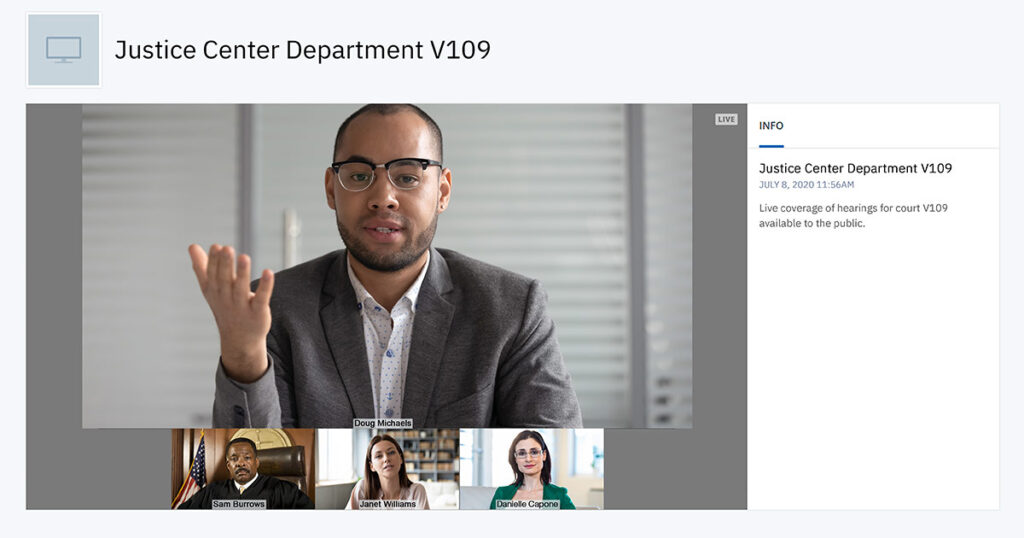
COVID-19 disrupted normal life. It forced organizations to pivot and adhere to guidelines related to the pandemic. The effect has been widespread, impacting private companies and government entities. This includes the judicial system in the United States, which is now faced with continuing day-to-day activities, but virtually.
This case study outlines how a superior court in California utilized IBM Video Streaming to broadcast court hearings live and was able to pivot from in-person to virtual in just two weeks. This not only satisfied a legal obligation to allow public access but resulted in giving the court a future proof solution that may be utilized even after things return to normal.
Virtual hearings
As the COVID-19 pandemic spread, a superior court in California was left with a dilemma: How could they run virtual hearings that adhered to social distancing guidelines for participants and provided the required public access to courtroom proceedings?
With no prior experience, the court tested out different technology in order to run hearings through remote video appearances. Due to some personnel tool preferences, they ended up choosing Cisco Webex Meetings in some courtrooms and Microsoft Teams in other courtrooms. These video collaboration tools enabled them to bring attorneys, defendants, and others into the courtroom virtually. The judge could then view and communicate with these individuals through the video collaboration interface.
The collaborative video session was just one piece of the puzzle, though. The courts also had a legal obligation to allow the public to observe the hearings, introducing a new challenge. To satisfy this obligation, the California based court decided to live stream the hearings, allowing for a larger audience to tune in, but not directly participate.
90 courts, 90 live streams
One of the biggest hurdles for live streaming the hearings was the sheer quantity required. The superior court needed 90 separate streaming channels that could potentially all be live at the same time, one for each courtroom. The initial plan was to have 30% of the courtrooms active per day, broadcasting four hours each, for a total of 120 hours a day. The courts wanted a solution for the future, though, one they could continue to use after the pandemic was over. As a result, finding something that could accommodate all 90 courtrooms was a requirement.
This requirement became an obstacle with vendors in the live streaming space. Due to the number of live streams, the superior court was given quotes of up to $30,000 a month across complex setups that mandated they purchase and run multiple accounts. The California based court even considered free platforms, but once more ran into volume issues as the number of channels all coming from the same IP address was too high for YouTube for example.
Leveraging IBM for courtroom streaming
After spending several weeks looking over live streaming solutions, the superior court ultimately selected IBM. The solution had been built with scale in mind, both in terms of supporting large viewership but in this case also being able to accommodate the large number of simultaneous live streams. As a result of this structure, the cost to the courts by going with IBM was 1/10th of some of the other bids they received. This ended up being a key factor as well, due to reduced budgets directly caused by COVID-19. Additionally, there were easy ways to stream the output of both the Cisco Webex and Microsoft Teams sessions, giving each judge and courtroom the flexibility to use the video collaboration tool they were most familiar with.
Two-week implementation
The journey from first engaging with IBM to going live was just two weeks and was done by a two-person team at the superior court. Through working with IBM, the courts were able to leverage existing APIs (application programming interface) to quickly create all 90 live channels. This enabled them to clone a channel’s settings and, through defining differences on a spreadsheet, quickly provision the other 89 in just a couple of hours.
The superior court was also able to bring this experience directly to their own website. This involved using one of IBM’s webhooks to visibly identify which of the 90 courtrooms were streaming live at any point in time. This webhook passed over the live status of content, which the courts leveraged to notify their website visitors from a central page that listed all the courtrooms and provided quick links to watch the live streams.
Live transcoding also ensured a mobile friendly experience for viewers. The court engineer who was responsible for the project stated, “We were surprised at how simple it was. In addition to the public viewing, it’s also been easy for our supervising judges and other staff to just click to watch the hearings.”
The court did have to figure out the setup differences between the courtrooms on Webex versus those on Microsoft Teams. For Webex, IBM provides a productized integration to broadcast these sessions directly from Webex Meetings to IBM. This allowed the judge or assistant in the courtroom to simply click a menu option inside of the Webex dashboard to begin streaming. For those on Microsoft Teams, the team decided to use a free tool called StreamLabs that would simply capture the screen via an encoder that would pass it to IBM. This allowed for flexibility if another collaboration technology was ever used for a hearing as well.
Overall success and future
The superior court has been streaming hundreds of hours of hearings each day. This has not only satisfied the legal requirement, but has been a resounding success, with certain hearings attracting over 250 simultaneous viewers. The courts also have a solution for the future, as they look to expand beyond live streaming toward additional functionality from IBM such as automatic archives and diving into the suite of analytic features offered.
If you’re interested in learning more about courtroom streaming, contact us for details related to IBM Video Streaming and this use case.